| Balloons Over Albuquerque October 2002 Page 4 |
Petroglyphs
On Monday morning we took our time getting around as check-in time at the Balloon Fiesta Park was scheduled for around noon. We took the opportunity to load up on propane to replace our depleted supply and to prepare for a few days of dry camping. I found that there is a little store located just inside the campground entrance. The small facility is in a trailer, but has a surprising variety of stuff in a small space.
Our move to the fiesta RV parking area was quick and uneventful. We benefited from our preview trip the day before to check out the route to the RV camping area. Our campsites were in the front row, next to the balloon landing field. We found later that we also had a nice nighttime view of the lights of Albuquerque through the front window of our motorhome.
We arrived early enough that we still had time for an afternoon activity. It was decided that we would go visit the Petroglyph National Monument, which is located nearby. On the way there I found that I had a problem with our car. The fan quit so that we no longer had air conditioning. Fortunately the air was cool so we were okay with the windows down.
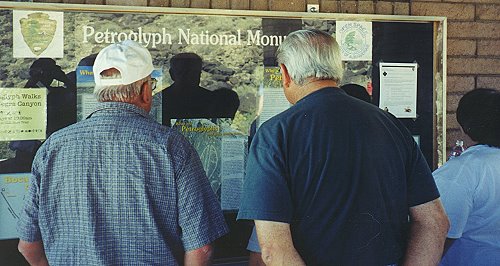 Our group checks out the information display |
We all checked out the visitor center to get information about the place and to get some maps. The center was undergoing some remodeling with a new concrete terrace and walkway being built. There was a silver craftsman, working under an umbrella to protect him from the sun, making beautiful jewelry creations as we looked on.
We drove to the trailhead loop and chose a couple of trails that were easier to walk. I found the petroglyphs to be very interesting. They are drawings of symbols and fetishes made by the indigenous people. Some petroglyphs looked very strange with some looking like space aliens. I thought of the book Chariots of the Gods written by Eric von Daniken.
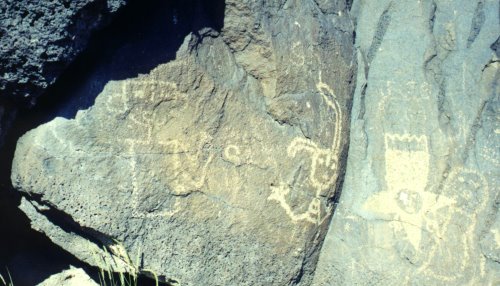 Many petroglyphs looked very strange |
The technique used was to chip away a dark layer of stone to reveal a lighter background. Most of what we saw was made from the 1300s to the 1600s. However, there were a few ancient petroglyphs that dated back more than 2000 years. We made our way to the beginning of a trail area where we found an information wall where we learned more about the park.
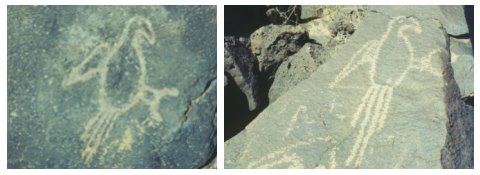 Similar petroglyphs — Demo on the left — The real thing on the right |
At the entrance to one of the loops there is a rock with a couple of distinctive petroglyphs. A sign explained that the petroglyphs are newly made so people can touch the images so as to feel the way they are made. It was very clear that the images are depressions chipped in the rock. The explanation also said that the simulated petroglyphs are copies of the real thing that can be seen along one of the trails.
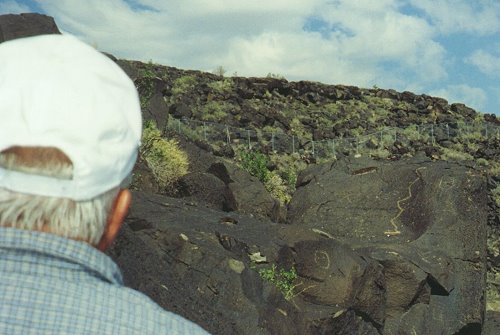 Petroglyphs seemed to be everywhere |
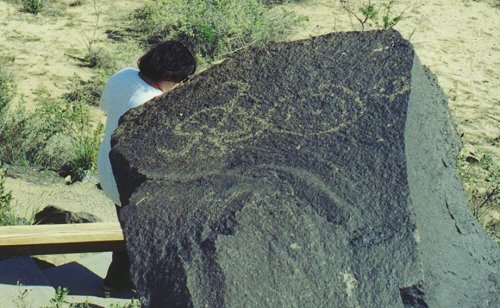 Around every corner were more petroglyphs |
The three couples on our group began walking on different loop trails that would intersect allowing us to come together toward the end of our walk. As we walked along petroglyphs seemed to be everywhere as far as the eye could see. I found that some of the images took on a different appearance as I moved along the trail. This changing effect seemed to come from the way the lighting came from different directions. One spiral shaped petroglyph was very hard to see from one direction while it stood out clearly when viewed from the other side.
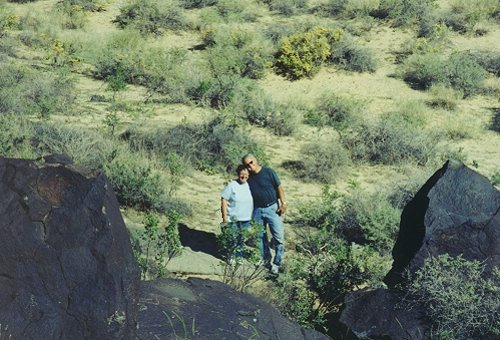 Two people in our group seen on a different trail |
At one location along the trail I looked back toward the park road and was struck by the encroachment of urbanization. A new housing development is being built very close to the National Monument. It is a result of the National Park Service not having the money to acquire enough land to keep development at bay. In the picture I took of the boundary fence is difficult to see, however, it can be seen going horizontally from one side to the other just above the center of the photo.
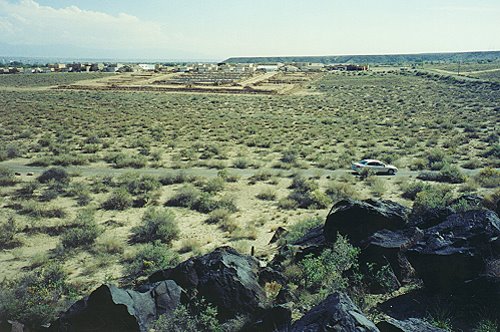 Development gets very close to the monument |
As we finished our walk through the ancient art gallery among the volcanic rocks, it was time to take a load off our feet for a while. We found a place in the shade near the information wall where we could rest for a short time before departing. A park ranger in the form of an attractive young woman sat down in the shade with us. We had a nice visit as she filled us in on details about the petroglyphs.
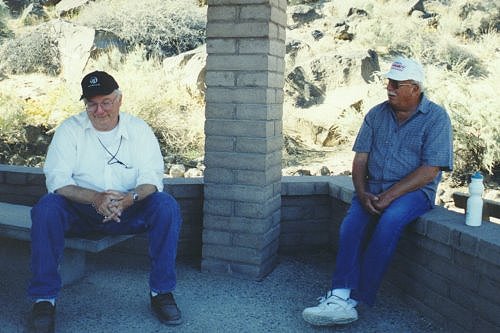 Tom and I cool off after a walk in warm weather |
While sitting there I noticed a plant that looked out of place in the desert. There were broad, dark green leaves that appeared spread out in a cluster near the sidewalk. The ranger told us that the plant was Jimsonweed also known as locoweed.
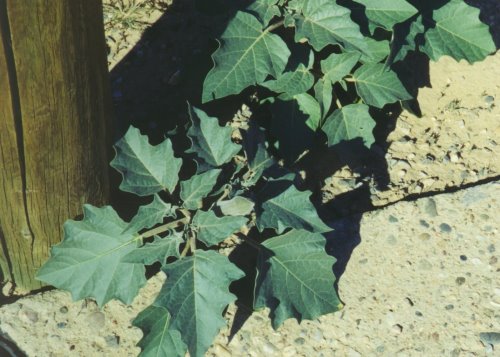 A small jimsonweed plant next to where we were sitting |
After leaving the petroglyphs, we went back to the edge of the Old Town area. From there we returned to the campground for dinner. After dinner, while Kay was watching Monday Night Football, I went for a walk in the dark. I came across Tom who was returning from a walk. We stopped to talk when I saw what appeared to be a firework display in the sky then I realized it was a huge meteor. I quickly pointed it out to Tom and it lasted long enough for him to see the meteor. It was probably the biggest and longest lasting meteor I've ever seen, bigger than the one I saw in Las Cruces, New Mexico in 1998.
At first the meteor was a big blue-green teardrop shaped fireball streaking from northwest to the southeast. About halfway through its appearance it began to break up into a smaller blue-green fireball with many smaller orange colored fireballs trailing behind. There were two events of breakup before the show ended abruptly. It was a huge meteor and a really great end to a very fun day.
| [ SUMMARY ] | [ PREV ] | [ NEXT ] | [ RV FUN TRIPS ] |
If you have comments or suggestions, please contact the .
Copyright 2003, RVFunTrips.com. All rights reserved.